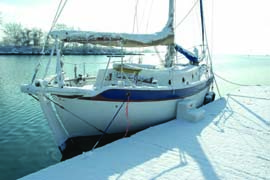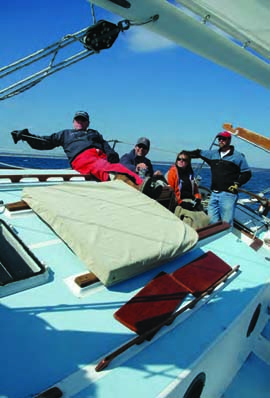by VINCENT PICA – COMMODORE, FIRST DISTRICT, SOUTHERN REGION (D1SR) – UNITED STATES COAST GUARD AUXILIARY

The arrival of November is a reminder that many months of kindly weather are behind us and many months of dark, cold and dreary weather are ahead of us. Even if you hand off your boat to your dockmaster and say, “See you in the spring,” there are some tips in here that you will want to be aware of. This column is about that.
“On the Hard” or In the Water?
Clearly, there are some basic steps to decommissioning and one of them is to get the boat safely “onto the hard.” Storing your winterized boat in the water can only be done in a very controlled environment with, generally, professional and near-constant attention. The only upside to storing your winterized boat in the water is that you don’t have to pay to haul the boat and return it to the water in the spring. I still believe that can be penny-wise and pound-foolish if this watery winter berth isn’t a very controlled environment…and 80% of boats that sink do so at the dock. So, let’s focus most of this column on wintering “on the hard.”
 Making a List and Checking It Twice
Making a List and Checking It Twice
If you are going to hand the boat over to someone else, do so with a written checklist, especially if you intend to do some of the work yourself. As you’ll see, the advice below is not 100% extensive. I’d need most of this magazine to give you a checklist that could be used by every boat. (If you want a copy of the BoatUS Seaworthy article on winterization, email me below and I will send you a copy.) So, work with your dockmaster by signing off on what will be done by the yard and, if you desire to be involved, by you.
• Change the oil and oil filters.
• Change the lubricant in engine transmission or the outboard lower unit.
• Apply engine fogging fluid if called for by manufacturer.
• Fill the boat’s fuel tanks completely.
• Add biocide and/or stabilizing agents to fuel.
• Change the fuel filters.
• Add antifreeze to the engine’s cooling system.
• Add distilled water to wet acid batteries, charge completely and disconnect.
Before covering the boat with shrink-wrap or canvas, inspect the hull. Any blisters in the gelcoat? If so, that must be addressed sooner rather than later because blistering will lead to water infiltrating the hull, making the boat less seaworthy. Stress cracks, which often develop at the bow, need professional attention. Just putting a patch over it and sanding won’t fix that one. It’s structural. As to washing and waxing, I opt for cleaning now and waxing in the spring.
Does the boat have a cabin of any kind? Get some “moisture-soaker-uppers” (i.e. desiccants) in there. They’re inexpensive and they inhibit the build-up of moisture that leads to mold. And don’t forget the hatches, closets and lazarettes.
Other than covering the boat, the “mechanical system” is the most obvious place to start. Your mechanical system may only be your outboard engine. If so, you are going to flush the engine with fresh water (attach a garden hose to the intake and let it flush – engine OFF!), “fog” the engine with lubricating oil (be sure the fuel system is disconnected from the engine when you start the process), clean/replace the spark plugs and fuel filter, lube the carburetor and anything else that moves – choke, cam, starter linkage etc. Don’t forget the lower unit (what the prop comes out of). Replace the lube oil. By the way, if you open the drain plug and water comes out first (oil floats), you need to replace the seal. Inspect the prop. Any dings? Have a professional look at that. A bad “wheel” can shake your engine apart.
So that’s just your outboard. Did I ask if you had a diesel engine or an I/O? Does the boat have a transmission? In-board water system (sink/shower)? Air-conditioner? Are your electronics staying aboard, or coming home? So, as you can see, the list is far more extensive than the short list above.
Keeping Her In?
OK, you want to keep her in as long as possible. This, I understand – and do. Here are the risks and what to do about it.
First, unless there is ice in the seaway leading from your marina (in which case it’s definitely time to get her on the hard), you have clear passage to all the creeks, bays, the Sound and the ocean. But ice in your boat’s systems is a different matter. For example, we all trim up the outboard engines on our powerboats at the dock or on the mooring to keep sea creatures from building up on – and in – the lower unit. But a small amount of water sits in there, even when trimmed up. And it will freeze long before the seaway does, and that could crack your engine.
Second, this implies that any water sitting in your boat can freeze – tanks for potable water, for example. Drain out any
and all.
Third, and a bit more insidious, is that when things get cold, like mooring lines, they lose a little of their elasticity. I always add an extra mooring line from my mooring ball to my bow – just in case there is a good, wintery blow and, instead of stretching just a bit, the mooring line snaps…
So, remember – have fun – but have “situational awareness,” as we say in USCG Forces! She’s your boat, and it is getting colder!
If you are interested in being part of USCG Forces, email me at JoinUSCGAux@aol.com or go direct to the D1SR Human Resources department, who are in charge of new members matters, at http://d1south.org/StaffPages/DSO-HR.php and we will help you “get in this thing.”
Captain Andrew Tucci is the Captain of the Port and Sector Commander for US Coast Guard Sector Long Island Sound. Captain Tucci is responsible for all active-duty, reservist and auxiliary Coast Guard personnel within the Sector. As Commodore of the US Coast Guard Auxiliary First District, Southern Region, Vin Pica works closely with Captain Tucci and his staff to promote boating safety in the waters between Connecticut, Long Island and 200 nautical miles offshore. Sector Long Island Sound Command Center can be reached 24 hours a day at 203-468-4401.




